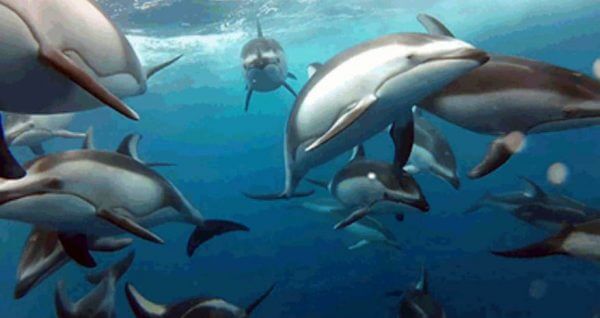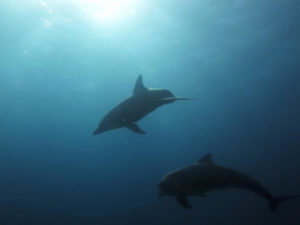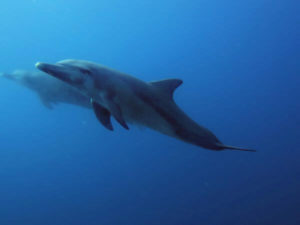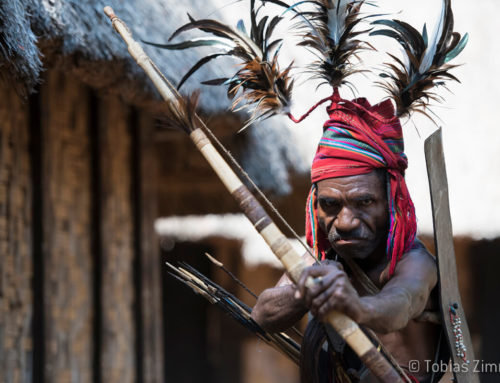Imagine yourself, relaxing on deck, a nice cup of java in your hand, a platter of warm croissants at your elbow and succulent fresh mango, papaya and pineapple sitting on your plate. Now take a deep breath of that fresh sea air, exhale, and take a look at the crimson sunrise off the port side bow. As if this isn’t delightful enough, you then spot a large pod of dolphins, slowly breaching the surface over and over again; making their way to their morning hunting grounds. Sounds nice, right? It is a rare trip to Komodo National Park on which we don’t see dolphins during our crossing; you may have to switch the scene for a sunset version, but yeah, this is pretty common.
So common you’ll frequently hear “Lumba lumba!!! Lumba lumba!!!” That’s the Indonesian word for dolphin and also the call to come on deck and watch them play. When you hear the call from the crew, grab your camera or video recorder and come marvel at these lovable mammals at play. Most would agree, no matter how often you see dolphins, you will still Oooo and Aaaa over their spins, dives and playful antics.
Indonesian seas are home to a wide range of whales and dolphins, with the deep-water channels between the islands being particularly productive. According to the Whale & Dolphin company, eighteen species have been recorded from around Komodo alone. The tropical cetaceans you can look for include Spinner, Spotted, Indo-pacific Bottlenose, Fraser’s and Rough-toothed Dolphins, as well as Melon-headed, False Killer and Pygmy Killer Whales. If you are super- lucky, you may see an Eden’s Whale, the little-known tropical baleen species.
Spinner and bottlenose dolphins are year-round residents, in Komodo National Park, so they account for most encounters. However, depending on the season, large whale species do migrate through the area. Because Komodo dive sites can be so fishy bottlenose dolphins have been seen hunting there giving unsuspecting divers a great show and insight into their hunting behaviors. While diving Castle Rock, a dive I will never forget, a female dolphin did a leisurely swim by with her calf! Was she somehow communicating with her baby “That’s right dear, too big to eat.” or wondering “Tsk tsk, those ‘shells’ on their back…how does that protect them?” Meanwhile the calf sees BUBBLES! Lots and lots of bubbles!
You can imagine the talk on the boat after that dive! How lucky are we to be able to enjoy our oceans and see these animals in their natural habitat?!?
Here are a few fun facts about dolphins that I found interesting and I think you will too.
Dolphin Fun Facts:
- Dolphins cannot shut down their brains when they sleep or they would drown. They get around that little problem by letting one half of their brain sleep at a time and swim in long slow u-patterns which periodically bring them up to the surface to breath – we frequently see large pods displaying this behavior, little did I know that they were trying to get some shut eye.
- The spinner dolphin (Stenella longirostris) is named after its acrobatic displays in which it spins along its longitudinal axis whilst leaping through the air.
- Spinner dolphins can make from two to five and a half spins in one leap; the swimming and rotational speed of the dolphin as it spins underwater affects the number of spins it can do while airborne.
- The deepest dive ever recorded for a bottlenose dolphin was a 300 meters (990 feet). This was accomplished by Tuffy, a dolphin trained by the US Navy. It is thought that dolphins do not commonly dive very deep though and spend much of their time in fairly shallow water.
- Aided by special structures in the skin that reduce turbulence, dolphins can swim up to 40 km(25mi)/hr but they are most energy efficient when swimming at speeds of about 8 km(5mi)/hr.
 The most surprising fact is how little we really know about these beguiling creatures. But one thing everyone knows is how sighting a pod of dolphins sends a wave of smiles across a ship and sets the tone for another fun day at sea.I couldn’t help including this GIF, although not filmed in Komodo, it’s too cute not to share. Click on the photo to the right for the dolphin show:
The most surprising fact is how little we really know about these beguiling creatures. But one thing everyone knows is how sighting a pod of dolphins sends a wave of smiles across a ship and sets the tone for another fun day at sea.I couldn’t help including this GIF, although not filmed in Komodo, it’s too cute not to share. Click on the photo to the right for the dolphin show:
Adelaar would like to thank Laura Leersnyder for the use of her photo. Check out the book “An Underwater Guide to Indonesia” written by R. Charles Anderson.












